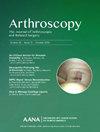髌骨不稳的髌股内侧韧带重建术后,对再次受伤的恐惧、心理因素和所从事的运动对恢复运动有负面影响。
IF 4.4
1区 医学
Q1 ORTHOPEDICS
Arthroscopy-The Journal of Arthroscopic and Related Surgery
Pub Date : 2025-05-01
DOI:10.1016/j.arthro.2024.05.022
引用次数: 0
摘要
目的:分析影响髌股关节内侧韧带重建术(MPFLR)术后恢复运动的因素,如心理因素、运动项目、术后忧虑测试阳性等,并确定平均恢复运动率和恢复运动时间:方法: 根据 PRISMA 指南进行文献检索。纳入的研究符合以下标准:患者因髌骨不稳接受了 MPFLR,记录了运动恢复情况,并提及了影响运动恢复的因素。搜索关键词包括髌股内侧韧带、胫骨结节截骨术、胫骨结节转移术、恢复比赛和恢复运动:结果:在已确定的 632 项研究中,有 18 项符合纳入标准。共记录了1072名接受了胫骨结节截骨术的患者。恢复运动率和平均/中位时间分别为 60.0%-100% 和 3-10.4 个月。55.6%-84.0%的患者重返运动场,且竞技水平没有下降。12 项研究中有 6 项(50.0%)报告称,害怕再次受伤是患者不重返运动场或重返较低水平运动场的首要原因。排球/手球术后恢复到相同水平的比例最低(18.2%-50.0%):结论:因复发性髌骨不稳而接受 MPFLR 的运动员重返运动场的比例为 60.0%-100%。结论:在复发性髌骨不稳之后接受 MPFLR 的运动员恢复运动的比例为 60.0%-100%,而恢复同一水平或更高水平运动的最高比例较低,为 55.6%-84.0%。研究发现,对再次受伤的恐惧和所从事的运动对重返运动场的能力有很大影响。外科医生可以利用这些信息向患者提供手术后的期望值建议:IV级,对III级和IV级研究的系统回顾。本文章由计算机程序翻译,如有差异,请以英文原文为准。
Fear of Reinjury, Psychological Factors, and Sport Played Have Negative Impact on Return to Sport Following Medial Patellofemoral Ligament Reconstruction for Patellar Instability
Purpose
To analyze factors that affect return to sport after medial patellofemoral ligament reconstruction (MPFLR), such as psychological factors, sport played, and a positive apprehension test following surgery, and to determine the average return to sport rates and time to return to sport.
Methods
A literature search was conducted according to Preferred Reporting Items for Systematic Reviews and Meta-Analyses guidelines. Included studies met the following criteria: patients underwent MPFLR for patellar instability, return to sport was recorded, and a factor that affected return to sport was mentioned. Search terms included medial patellofemoral ligament, tibial tubercle osteotomy, tibial tubercle transfer, return to play, and return to sport.
Results
Eighteen of 632 identified studies met inclusion criteria, and 1,072 patients who underwent MFPLR were recorded. Return-to-sport rates and mean/median time ranged from 60.0% to 100% and 3 to 10.4 months, respectively. Of the patients, 55.6% to 84.0% returned to sport without decreasing the level of competition. Six of 12 studies (50.0%) reported fear of reinjury as the top reason for patients not returning or returning at a lower level of sport. Volleyball/handball had the lowest return to the same level following surgery (18.2%-50.0%).
Conclusions
Athletes who underwent MPFLR following recurrent patellar instability returned to sport at a range of 60.0% to 100%. Return to sport at the same level or higher was found to have a lower maximum rate at 55.6% to 84.0%. Fear of reinjury and sport played were found to have a substantial impact on ability to return to sport. Surgeons can use this information to advise patients on expectations following surgery.
Level of Evidence
Level IV, systematic review of Level III and IV studies.
求助全文
通过发布文献求助,成功后即可免费获取论文全文。
去求助
来源期刊
CiteScore
9.30
自引率
17.00%
发文量
555
审稿时长
58 days
期刊介绍:
Nowhere is minimally invasive surgery explained better than in Arthroscopy, the leading peer-reviewed journal in the field. Every issue enables you to put into perspective the usefulness of the various emerging arthroscopic techniques. The advantages and disadvantages of these methods -- along with their applications in various situations -- are discussed in relation to their efficiency, efficacy and cost benefit. As a special incentive, paid subscribers also receive access to the journal expanded website.

 求助内容:
求助内容: 应助结果提醒方式:
应助结果提醒方式:


